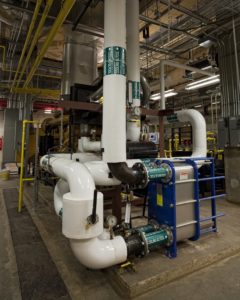 The heat exchanger is a critical component of the heating system in your commercial building. Proper maintenance of the heating system will allow it to run efficiently and keep your building space warm and comfortable on the coldest of days.
The heat exchanger is a critical component of the heating system in your commercial building. Proper maintenance of the heating system will allow it to run efficiently and keep your building space warm and comfortable on the coldest of days.
Like any mechanical system, a heat exchanger has a finite life cycle. Dirt and grime can build up on the plates and tubes, causing clogs and forcing it to work harder. This can result in higher energy bills. Because the heat exchanger is one of the most expensive parts of a heating system to replace, a breakdown can cost you thousands of dollars and down time for your business.
There are many types of heat exchangers, but this blog will cover the tube and shell unit that is common in many commercial buildings. As a building manager, you will want to know what to do if faced with a situation in which a heat exchanger tube bundle repair is required, and why regular maintenance is necessary.
How It Works
The heat exchanger, as the name suggests, transfers and radiates heat. In a tube and shell unit, fluid flows through a bundle of tubes encased in the pressurized vessel that is the shell. The tube bundle may comprise several types of tubes operating within the unit. Another fluid flows within the shell and over the tube bundle to create the flow of heat that is distributed throughout the building.
Troubleshooting
A drop-in pressure is one of the telltale signs that the tube and shell heat exchanger is experiencing problems. This may indicate that not all of the flow is entering the tubes as it should due to potential corrosion or a gasket leak. In cases like this, heat exchanger tube bundle replacement is the typical course of action.
Another problem sign is a loss of heat transfer that can be traced to severe fouling of the tubes from sediment, corrosion or debris. Tube vibration damage from the unit operating at high velocity is another problem that can become significant over the course of time. Frequent shutdowns and cycling can cause the tubes to loosen and leak fluid into the shell. If you detect any of these potential signs of failure, you may be looking at an expensive remediation.
Preventive Action
The best course of action is preventative maintenance. A tube and shell heat exchanger can last up to 20 years with the right maintenance. You should schedule servicing for the heat exchanger in your building regularly, at least once a year.
This should be done by an experienced technician trained in inspecting, cleaning and servicing this type of unit. The technician can recommend if a heat exchanger tube bundle repair is needed, or more extensive work is required. Regular maintenance and monitoring the performance of your heat exchanger will deter potential problems before they become a larger issue.
